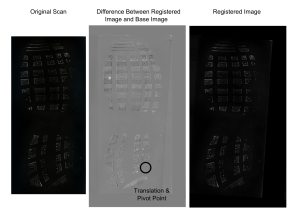Richetelli, N., Bodziak, W., Speir, J. Empirically Observed and Predicted Estimates of Chance Association. Part 1: Estimating the Chance Association of Randomly Acquired Characteristics in Footwear Comparisons. Forensic Science International. September 2018. Accepted.
Petraco, N.D.K., Berry, R., Del Valle, A., Gambino, C., Kammrath, B., Speir, J., Shenkin, P. Specific pattern identification via computer matching systems. Circa 2017. Under Revision
Watalingam, R.D., Richetelli, N., Pelz, J., Speir, J. Eye tracking to evaluate evidence recognition in crime scene investigations. Forensic Science International. Vol. 280, 2017, pp. 64-80.
Richetelli, N., Lee, M., Lasky, C., Gump, M., Speir, J. Classification of footwear outsole patterns using Fourier transform and local interest points. Forensic Science International. Vol. 275, 2017, pp. 102-109.
Richetelli, N., Nobel, M., Bodziak, W., Speir, J. Quantitative assessment of similarity between randomly acquired characteristics on high quality exemplars and crime scene impressions via analysis of feature size and shape. Forensic Science International. Vol. 270, 2017, pp. 211-222.
Speir, J., Richetelli, N., Fagert, M., Hite, M., Bodziak, W. Technical Note: Quantifying randomly acquired characteristics on outsoles in terms of shape and position. Forensic Science International. Vol. 266, 2016, pp. 399-411.
Pieszala, J., Diaz, G., Pelz, J., Speir, J., Bailey, R. 3D Gaze Point Localization and Visualization Using LiDAR-based 3D Reconstructions. In Proceedings of the Ninth Biennial ACM Symposium on Eye Tracking Research & Applications (ETRA `16). ACM, New York, NY, USA, 201-204.
Speir, J., Hietpas, J. Frequency Filtering to Suppress Background Noise in Fingerprint Evidence: Quantifying the Fidelity of Digitally Enhanced Fingerprint Images. Forensic Science International. Vol. 242, 2014, pp. 94-102.
Hietpas, J., Samson, S., Speir, J., Moecher, D. Assessing detrital garnet chemical composition as a quantitative provenance tool: A multivariate statistical approach. Journal of Sedimentary Geology. Vol. 83, No. 12, 2013, pp.181-1197.
Petraco, N.D.K., Shenkin, P., Speir, J., Diaczuk, P., Pizzola, P., Gambino, C., Petraco, N. Addressing the National Academy of Sciences’ Challenge: A Method for Statistical Pattern Comparison of Striated Tool Marks, Journal of Forensic Sciences, Vol. 57, No. 4, 2012, pp. 900-911.
Speir, J., Goodenough, A., Schott, J., Brown, S. Validation of In-Water 3D Radiative Transfer using DIRSIG. IEEE Hyperspectral Image and Signal Processing: Evolution in Remote Sensing (WHISPERS), 2010, 2nd Workshop, Reykjavik, Iceland 2010, pp. 1-4.
Speir, J. A Case Study: The Observation of Dispersed Extinction in Fibrous Richterite/Winchite. The Microscope. Vol. 54, 1st Quarter, 2006, pp 25-29.
Speir, J. Cleaning, Maintenance and Adjustment of the Light Microscope. The Microscope. Vol. 54, 2nd Quarter, 2006, pp 61-70.







